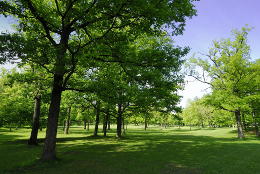How to Grow Tall Fescue Grass in the Shade
 Tall fescue grass is an excellent cool-season variety for a lawn. Its deep root system allows it to be extremely drought tolerant, so you can plant fescue grass seed in soils with poor fertility, and it can tolerate some shade, although it prefers sunny areas. But if you have ever dealt with shaded grass, you’ll know that thinning is almost inevitable. So how do you deal with a shaded tall fescue lawn?
Tall fescue grass is an excellent cool-season variety for a lawn. Its deep root system allows it to be extremely drought tolerant, so you can plant fescue grass seed in soils with poor fertility, and it can tolerate some shade, although it prefers sunny areas. But if you have ever dealt with shaded grass, you’ll know that thinning is almost inevitable. So how do you deal with a shaded tall fescue lawn?
The key to remember is that any shaded grass will be performing less overall photosynthesis because it is exposed to less sunlight. Therefore, the shaded grass will have less energy stores at its disposal, which means it will grow more slowly and take a longer time to recover from disease and injuries. You should keep all of this in mind as you maintain this area of your lawn.
First of all, you shouldn’t have to water shaded grass as frequently. Water is used to perform photosynthesis, so less water should be used in proportion to the decreased amount of sunlight. Too much water can also exacerbate humid conditions in the shade and encourage fungi pathogens to grow. Tall fescue doesn’t need much water anyway, so you should only irrigate when you see the classic signs of water deprivation: the grass will turn bluish gray and the leaves will wilt. Don’t water the area just because the sunned grass is starting to look water deprived. Wait until the shaded grass needs it!
Don’t fertilize as frequently either. Too much nitrogen, at the very least, can push the grass to deplete all of its food stores in creating new growth. The result is very tall and very weak grass. At the very worst, an excess of nitrogen can burn the grass. Let the shaded tall fescue reserve as much energy as possible for sustaining itself.

Tall fescue grass is fairly traffic tolerant, but it’s a different story with shaded grass. Because the shaded tall fescue does not get as much “food” as its sunned counterpart, it will not have extra energy to spend repairing torn, worn, or crushed grass leaves. Do your shaded grass a favor and avoid walking across it.
If shade is caused by tall trees, you should make sure that all branches within eight feet of the ground are pruned. This will help lessen the overall humidity and improve air circulation. It will also allow more sunlight through. If, after following all these suggestions, your tall fescue grass is still suffering in the shade, you have a couple of options. You can either reseed the area with the more shade-tolerant fine fescue grass varieties, or you can remove some of the shade sources. Whichever you choose will be a good alternative to nursing a continually struggling lawn in the shade.


